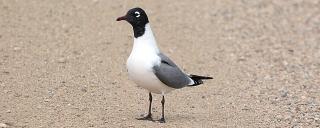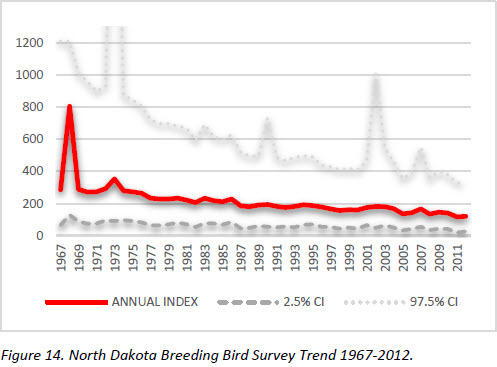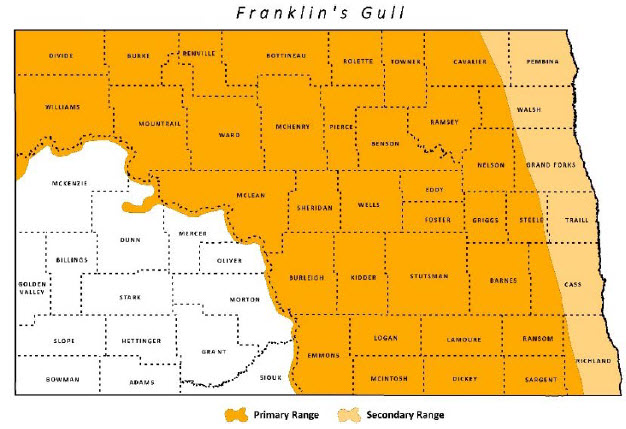
Franklin's Gull
| Scientific Name | Leucophaeus pipixcan |
|---|---|
| General Description | L 14.5”, WS 36”, 10 oz. Black head, large white spots on black wing tips, breeding adults have red bill. |
| Status | Occurs in North Dakota from April to October. Peak breeding season occurs from late May to mid-July. |
| Abundance | Common to abundant. |
| Primary Habitat | Large wetlands with semi-open emergent cover, often feeds in cultivated agricultural fields. |
| Federal Status | Migratory Bird. |
| Reason for Designation | North Dakota is host to several large colonies. Roughly 1/3 of the entire population nests in the Prairie Pothole Region. The species is designated as High Concern in the Northern Prairie and Parkland Waterbird Conservation Plan (NPPWCP) and Moderate Concern by Waterbird Conservation for the Americas. |
Locations and Conditions of Key Habitat
Preferred Habitat
Nesting colonies occur in extensive prairie wetlands with cattail, bulrush, or other emergent vegetation. Nests built of floating mats of vegetation, on muskrat houses, or other debris. Water depth at nest varies from 15-180 cm. During the nesting period, individuals stay generally within 30km of colony. Forage over water or in agricultural fields for flying insects, grains/seeds, dragonflies, earthworms, grasshoppers, and other matter.
Key Areas and Conditions for Franklin's Gull in North Dakota
Lake Alice National Wildlife Refuge near Devils Lake in western Ramsey County hosted a colony of nearly 17,000 pairs in 1999 and 25,000 pairs in 2000 (Brice 2003). This refuge is one of four major reproduction sites for Franklin’s Gull in North America; J. Clark Sayler NWR is another of the four. Other key breeding colonies in North Dakota include Beaver Lake Waterfowl Production Area, Burke County; Rush Lake Waterfowl Production Area, Pierce County; and McHugh Slough, Nelson County.
Problems Which May Affect this Species
Habitat
Destruction and/or degradation of wetlands are major factors affecting Franklin’s Gulls.
Other Natural or Manmade Factors
Rather susceptible to botulism outbreaks. The effect of certain agricultural pesticides on this species is unknown. Franklin’s Gulls are sensitive to human disturbance and could abandon a colony if excessive disturbance occurs, particularly during the pre-nesting period. High mortality from collisions power lines. Expanding oil and gas development in North Dakota increases risk of oilfield contamination of wetland habitat.
Research and Survey Efforts
Current Research or Surveys
- Rocky Mountain Bird Observatory (ND SWG T-40-R) is conducting a statewide inventory of colonial and semi-colonial waterbird populations and identifying key sites for breeding colonies in North Dakota. The Franklin’s Gull is one of 29 target species. The project was initiated in March 2014.
Previous Research or Surveys
- University of North Dakota and North Dakota State University (ND SWG T2-4-R) determined relationships among landscape composition, nesting density, chick condition, and adult condition and reproductive success in Franklin’s Gull. The project was initiated in April 2009 and continued through June 2012.
- Clark and Reed (2012) examined seasonal interactions between photoperiod and maternal effects determine offspring phenotype. They suggest “differences in phtoperiod resulting from earlier nesting or from shifts in habitat across latitudes can alter avian embryonic development and size at hatching, which is an unexplored consequence of climate change.”
- Krmpotich (2012) completed a thesis on the phylogeography and habitat associations of Franklin’s Gulls. Franklin’s Gulls in the breeding range of the United States are a panmictic population because of high levels of genetic variation. Habitat use depends on multiple variables, suggesting wetland complexes are key to persistence of nesting colonies.
- Weissenfluh (2011) completed a thesis on the seasonal variation in physiological condition of adult Franklin’s Gull. Physiological condition declined across the breeding season and suggested two hypotheses 1) timing of nesting has significant impact on the physiological condition and 2) birds in poorer condition initiate breeding later in the season. Climate change may further affect the physiological condition of nesting adults.
- Brice (2003) conducted a study of 8 different colonial nesting waterbirds at Lake Alice NWR in western Ramsey County during 1999 and 2000. Franklin’s Gulls nested exclusively in cattails and in areas of greater water depth in comparison to past studies.
- Numerous published reports and gray literature throughout the species range.
Additional Research or Surveys Needed
- Determine influence of other gull species on Franklin’s Gull ecology.
- Develop better understanding of colony dynamics, including determinants of colony location and consistency of use of individual sites.
- More accurately estimate population size, distribution, and trend.
- Identify and target high priority landscapes and habitats, including staging areas.
- Determine the effects of contaminants or insecticides on wetland quality and prey species.
Population and Trend Estimates

- North American Waterbird Conservation Plan Population Estimate: 315,608 – 990,864 breeders
- NPPWCP BCR11 Population Estimate: 183,600 – 689,400
- North Dakota BBS Trend: see figure 14
- Survey-wide BBS Trend 1966-2012: -3.95
Management Recommendations
- Identify and target high priority landscapes, habitats, and staging areas for protection.
- If possible, maintain water levels during nesting.
- Utility development should follow the guidance of “Reducing Avian Collisions with Power Lines” including marking power lines and creating an Avian Protection Plan.
Monitoring Plans
The NPPWCP has identified the basic elements of how a regional/continental waterbird monitoring program should be structured. Waterbird monitoring should follow recommendations of the Waterbird Conservation for the Americas and North American Bird Conservation Initiative ‘Opportunities for Improving Avian Monitoring’.
2005-2015 Progress
The Franklin’s Gull remains a Level I Species of Conservation Priority. Efforts to identify additional breeding colonies are underway. The species remains at-risk primarily due to the overall limited number of colonies in North America (less than 50 total, less than 20 in the United States). Several State Wildlife Grant Projects (T2-9-R, T-18-R, T-27-HM) have contributed to habitat enhancement of wetlands for Franklin’s Gulls and other wetland dependent birds.

Note: A listing of works consulted when compiling the information on this page may be found in the 2015 State Wildlife Action Plan.
